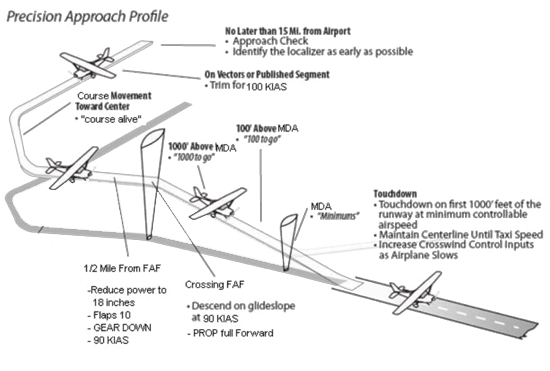INTRODUCTION
This manual is a compilation of flight training maneuvers and procedures for the Cessna 172RG. This manual provides standardized procedures for completing each VFR and IFR maneuver required by the FAA’s Practical Test Standards for the Private Pilot Practical Test
This manual does not take the place of current FAA publications. References to those publications should be used in order to enhance the students understanding of each maneuver.
It is important to keep in mind that this manual provides only a standardized guide to performing each maneuver, and that actual pitch or power settings may vary. All VFR maneuvers should be completed with references to pitch attitude made using the horizon. All IFR maneuvers should be completed with references to pitch attitude made using the attitude indicator.
The student should be aware that small adjustments to pitch and power should be made in flight in order to successfully complete each maneuver.
It is the instructor’s responsibility to teach each maneuver based upon this guide and to ensure the student fully understands and can perform each maneuver required.
This manual should serve only as a guide to completing the required maneuvers and should not be used in place of competent instruction or thorough and complete study of FAA publications.
Students should use this manual in combination with the Airplane Flying Handbook, the Instrument Flying Handbook, the Pilot’s Handbook of Aeronautical Knowledge, the FAA Practical Test Standards, and any other relevant FAA documents.
GENERAL FLIGHT PROCEDURES
These are the normal procedural steps to be followed when conducting training in the CESSNA 172RG under Visual Flight Rules and Instrument Flight Rules. All maneuvers will require the pre--maneuver checklist to be completed prior to commencing each maneuver.
MINIMUM ALTITUDES
Simulated engine failures will be practiced on dual flights only and will not descend below 500 ft. above ground level. With the exception of ground reference maneuvers, all maneuvers will be completed no lower than 2500 ft. above ground level.
CLEARING TURNS
A minimum of two clearing turns are required before each maneuver to ensure there is no traffic in the area. Clearing turns should be done at a bank angle of 30° with each turn being at least 90°. There must be a break between each turn (one 180° turn does not substitute for two individual 90° turns). Emphasis should be placed on keeping the aircraft in a limited geographic area to complete the maneuver.
POSITIVE EXCHANGE OF FLIGHT CONTROLS
During flight training, there must always be a clear understanding between student and flight instructors of who has control of the aircraft. A positive three--step process in the exchange of flight controls will be conducted.
When the instructor wishes the student to take control of the aircraft, he or she will say, “You have the flight controls.” The student will acknowledge by saying, “I have the flight controls.” The flight instructor again says, “You have the flight controls.” When control is returned to the instructor, follow the same procedure. A visual check by both student and instructor to verify the exchange is also recommended.
BRIEFINGS
To ensure a positive flight training experience, briefings should be used for certain phases of flight so that all parties involved understand important characteristics of the flight.
PASSENGER BRIEFINGS
During the “Before Start” checklist, each aircraft occupant should be thoroughly briefed on:
- Seatbelt operation.
- Fire Extinguisher location and use
- Emergency Exits
- No smoking.
- Engine Fire during start
DEPARTURE BRIEFINGS
During the “Before Takeoff” checklist, the pilot should give a takeoff briefing that includes:
- Who is taking off?
- Runway in use.
- Runway in length
- Applicable aircraft V--speeds. (Ground Roll, Below 1000ft, and Above 1000ft)
- Takeoff distances.
- Emergency procedures during takeoff.
- Positive exchange of flight controls.
- ANY QUESTIONS?
APPROACH BRIEFINGS
When approaching an airport for landing under VFR, the pilot should give an approach briefing that includes:
- Active runway.
- Current ATIS/Weather
- Type of landing.
- Landing distance. For IFR flights, the pilot should use the approach plate as a guide to give the approach briefing proceeding from the header to the minimums section of the approach plate.
- Frequencies.
- Inbound final approach course.
- MDA or DA.
- Timing.
- Missed approach procedure.
SPARK PLUG CLEARING PROCEDURES
An excessive drop in engine RPM during the magneto ground check is often due to a fouled spark plug. The following procedure should be used for clearing a fouled spark plug:
- Verify the engine oil temperature gauge is within the normal operating range or, “In the green arc”.
- Verify that the magnetos are set to both.
- Smoothly apply power to 2000 RPM.
- Lean the mixture until the first indication of an RPM drop or engine roughness.
- Maintain this mixture and RPM combination for 20--30 seconds.
- Move the mixture control to full rich while simultaneously reducing power to 1800 RPM. Perform the magneto check again and if within limits continue with the before takeoff checklist. If not, return to step #3 and repeat the spark plug clearing procedure.
- If after the second attempt the magneto drop is still out of limits, return to the ramp for maintenance and advise flight operations. DO NOT ATTEMPT a 3rd clearing procedure.
CLEARING TURNS OBJECTIVE
To determine that the airspace surrounding the airplane is clear of other traffic before starting any maneuver DESCRIPTION:
- Visually scan the areas left, right, above and below the airplane
- Gently lower the wing on the side of the first intended turn and visually scan the area previously blocked by the wing
- Perform two medium bank 90--degree turns in the same or opposite directions
- If any traffic that might be a factor is observed, the pilot flying should immediately announce it
- Rollout wings level and start the maneuver
- Turning maneuvers should be made in the direction of the last cleared area
- Perform “Cruise Checklist”
PRE--MANEUVER CHECKLIST
OBJECTIVE: To ensure proper aircraft configuration prior to performing any maneuvers
CONDITIONS: This checklist must be accomplished prior to the start of any maneuver
DESCRIPTION:
- Fuel Selector valve…………………………………….…………………PROPER TANK
- Carb Heat…………………………………….……………………….……….AS REQUIRED
- Mixture………………………………………………………….……………….…………. RICH
- Landing Light…………………………………………….…………………………….……..ON
- Master……………………………………………………….……………………….………….ON
- Ignition…..…………………………………………………………………………….……BOTH
- Seat Belts……………………………………………………..………………………SECURED
- Position Report…………………………………………..………………..……COMPLETE
- Clearing Turns…………………………………………………………….….….COMPLETE
- Selection of Emergency landing site……………………………………..CHOSEN
TAXI OPERATIONS
Taxiing is the controlled movement of the airplane under its own power while on the ground. Since an airplane is moved under its power between the parking area and the runway, the pilot must thoroughly understand and be proficient in taxi procedures.
- A taxi clearance must be obtained from ground control prior to moving an aircraft onto the airport movement area when an air traffic control tower is in operation.
- At an airport without a control tower or when the tower is closed, the pilot should announce his or her intentions to taxi on the appropriate frequency.
- When first beginning to taxi, the brakes should be tested for operation as soon as the airplane is put in motion. If braking action is unsatisfactory, the engine should be shut down immediately.
- Steering the airplane is accomplished with rudder pedals and minimal usage of brakes. Turns should be made at a slow, safe speed.
- The taxi speed should be slow enough so that when the throttle is closed the airplane can be stopped promptly.
- When yellow taxiway centerline stripes are provided, the airplane’s nose wheel should remain on the line unless necessary to clear other airplanes or obstructions.
- In no--wind, the ailerons and elevator controls should be held in a neutral condition.
- In windy conditions;
- Headwind: Deflect ailerons into the wind, neutral elevator
- Tailwind: Deflect ailerons away from the wind, elevator full forward.
- While taxiing, clear all taxiway and runway intersections visually and verbally, i.e.” Clear left, clear center, clear right.” Also, when taxiing onto an active runway clear the final approach paths in both directions.
- Although ATC issues a taxi clearance, it is the pilot’s responsibility to avoid collision with other aircraft, vehicles, and objects on the ground.
TRAFFIC PATTERN OPERATIONS
Entry
- Enter at 45° to the downwind at a point abeam of midpoint of the runway in use unless directed otherwise by Air Traffic Control.
Downwind Leg
- Maintain ground track parallel to and approximately ¼ to ½ mile out from landing runway. (About half way up on the wing strut)
- Maintain traffic pattern altitude ± 100 feet.
- Commence Before Landing Checklist no later than abeam midpoint of runway when entering downwind leg from crosswind leg. Gear Down at Midfield Downwind--1st configuration check
- Abeam touchdown point, reduce power to approximately 12 Inches MP. Maintain attitude with pitch control. Verify speed is within the white arc, extend flaps 10o. Decelerate to 85 KIAS abeam of intended touchdown point.
- Turn base when intended touchdown point is approximately 45o behind wing.
Base Leg
- Maintain 75 KIAS during turn to base leg.
- Maintain ground track perpendicular to extended centerline of runway, downwind to base turn, flaps 20o, (2nd Notch). 2nd Gear configuration check
- Turn final with a maximum 20o angle of bank so as to roll out on extended centerline of runway at least ¼ mile from approach end of runway.
Final Approach
- Maintain ground track over extended centerline of runway.
- Extend flaps to 30o, unless winds preclude full flaps.
- Reduce airspeed to 65 KIAS or as necessary for the type of approach being used.
- Adjust pitch and power as necessary to maintain airspeed and descent angle. 3rd and final Configuration Check
- If at any time you do not have a stabilized approach, a Go Around should be initiated.
- Exit runway at next taxiway or as directed, if full stop, clear runway, stop airplane, complete “After Landing Checklist”, and contact ground.
Departure Leg
- Maintain ground track over centerline or extended centerline of runway.
- Climb at airspeed appropriate to type of takeoff until reaching traffic pattern altitude.
- If remaining in traffic pattern, turn crosswind at 300 feet below traffic pattern altitude and beyond departure end of runway. If departing traffic pattern, continue straight ahead or turn from the takeoff leg when within 300 feet of traffic pattern altitude.
Crosswind
- Maintain ground track perpendicular to extended centerline of runway.
- Climb at airspeed appropriate to type takeoff until reaching traffic pattern altitude.
NORMAL AND CROSSWIND TAKEOFF AND CLIMB
- Complete “Takeoff Checklist”.
- Flaps -- UP.
- Align airplane on runway centerline.
- Determine wind direction and speed, and hold aileron into wind.
- Advance throttle smoothly to maximum power.
- Maintain directional control on runway centerline using rudders.
- Adjust ailerons as necessary for existing wind conditions.
- Verbally verify “Airspeed alive and Engine Instruments are in the Green. “
- Lift nose wheel at recommended airspeed and accelerate to VY.
- Positive rate of climb and no more useful runway, GEAR UP
- Climb at VY with takeoff power.
- Maintain ground track over extended runway centerline until a turn is required.
- At 500ft AGL, Set Climb Power and Complete “Climb Flow”
- Set Propeller to 2500 RPM, Manifold Pressure to 25 in.
- At 300ft below Traffic Pattern altitude, initiate a turnout to the desired direction.
- Complete Climb Checklist at or above 1000 feet AGL
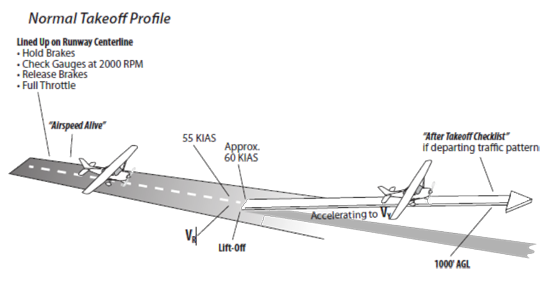
SHORT--FIELD TAKEOFF AND CLIMB
- Complete “Takeoff Checklist” appropriate for aircraft.
- Position aircraft at beginning of runway aligned on centerline.
- Determine wind direction and speed; hold aileron into wind.
- Apply brakes and smoothly advance throttle to maximum power.
- Check engine instruments “Green” and release brakes.
- Verbally verify “Airspeed alive and Engine Instruments are in the green. “
- Maintain directional control on runway centerline.
- Adjust ailerons as necessary for existing wind conditions.
- Rotate at Recommended airspeed and accelerate to VX.
- Climb at 63 KIAS until obstacle is cleared by at least 50 feet, then accelerate to Vy
- Positive rate of climb, out of useful runway, GEAR UP
- Maintain VY and takeoff power.
- Maintain ground track over extended runway centerline until a turn is required.
- At 500ft AGL, Set Climb Power and Complete “Climb Flow”
- Set Propeller to 2500 RPM, Manifold Pressure to 25 in.
- At 300ft below Traffic Pattern altitude, initiate a turnout to the desired direction
- Complete Climb Checklist at or above 1000 feet AGL
SOFT--FIELD TAKEOFF AND CLIMB
- Complete “Takeoff Checklist” appropriate for aircraft.
- If no obstacles during takeoff, Set Flaps to 10°.
- Taxi with full nose up elevator.
- Align aircraft on takeoff path without stopping.
- Determine wind direction and speed; hold aileron into wind.
- Advance throttle smoothly, maintain maximum power.
- Verbally verify “Airspeed alive and Engine Instruments are in the Green. “
- Maintain directional control on center of takeoff path.
- Adjust ailerons as necessary for existing wind conditions.
- Liftoff as soon as practical and remain in ground effect while accelerating.
- Accelerate to and maintain VX or VY as appropriate.
- Slowly retract flaps at safe altitude and airspeed (greater than 200 feet AGL).
- Positive rate of climb, out of useful runway, GEAR UP
- Maintain VY and takeoff power 15. Maintain ground track over extended centerline of runway.
- At 500ft AGL, complete “Climb Flow”.
- Set Propeller to 2500 RPM, Manifold Pressure to 25 in.
- At 300ft below Traffic Pattern altitude, initiate a turnout to the desired direction.
- Complete Climb Checklist at or above 1000 AGL
STALLS -- POWER OFF
- Complete Pre--Maneuver Checklist
- Select entry altitude that will allow recovery to be completed no lower than 2500 feet AGL.
- Select a visual outside reference and a simulated ground altitude no more than 500 feet below entry altitude.
- Reduce power to 12 Inches MP.
- Below 140 Knots--Gear Down. “Verify Green Light”
- Below 130 knots-- 10° FLAPS
- Below 100 Knots-- Prop Full Forward
- Below 100 knots-- FULL FLAPS
- Maintain assigned altitude and heading as aircraft slows to 65 knots or approach speed.
- Establish a stabilized glide at 65 KIAS until 100 feet above simulated ground altitude.
- Reduce power to IDLE and increase pitch for a stall.
- Maintain a specific heading ±10o, and angle of bank not to exceed 20o if in turning flight, while inducing a stall.
- Recognize and announce stall warning horn.
- Bring to imminent stall (COMMERCIAL)
- Promptly recover by simultaneously adding full power, decreasing angle of attack, level wings, FLAPS set to 20°.
- Establish a positive rate of climb, Set Flaps 10°.
- Accelerate to Vx.
- With a Positive rate of climb, GEAR up
- above 65 Knots: retract remaining flaps while maintaining positive rate of climb
- Climb at Vy and set Power to 25 Inches MP, and prop to 2500 rpm.
- Resume normal cruise, Cruise checklist.
FULL STALLS -- POWER ON (Takeoff Configuration)
- Complete Pre--Maneuver checklist
- Select a visual outside reference. Match it with Heading Indicator.
- Select entry altitude that will allow recovery to be completed no lower than 2500 feet AGL.
- Reduce power to 12 inches MP.
- Below 140 Knots-- Gear Down. “Verify Green Light”
- Below 100 Knots-- Prop Full Forward
- Maintain assigned altitude and heading as aircraft slows to 55 knots or adjusted rotation speed.
- Maintain assigned heading or, if stall is to be done in a turn, establish maximum 20o angle of bank. 9. At 55 KIAS, apply 25 inches MP, and pitch for a stall.
- Bring to imminent stall (COMMERCIAL)
- Promptly recover by simultaneously adding full power, decreasing angle of attack, level wings.
- Avoid secondary stalls, excessive airspeed, or altitude loss, spins, and flight below 1500 AGL.
- Accelerate to Vx.
- With a Positive rate of climb, GEAR UP.
- Accelerate to VY and continue positive rate of climb.
- Resume normal cruise, Cruise checklist.
FULL STALLS -- POWER ON (Departure Configuration)
- Complete Pre--Maneuver checklist
- Select a visual outside reference. Match it with Heading Indicator.
- Select entry altitude that will allow recovery to be completed no lower than 2500 AGL.
- Reduce power to 12 inches MP.
- Below 100 Knots-- Prop Full Forward
- Maintain assigned altitude and heading as aircraft slows to Vx.
- Maintain constant heading or, if stall is to be done in a turn, establish maximum 20o angle of bank.
- At 67 knots, apply 25 inches MP, and pitch for a stall.
- Bring to imminent stall (COMMERCIAL)
- Promptly recover by simultaneously adding full power, decreasing angle of attack, level wings.
- Avoid secondary stalls, excessive airspeed, or altitude loss, spins, and flight below 1500 AGL.
- Climb at Vx and set Power to 25 Inches MP, and prop to 2500 rpm.
- Accelerate to VY and continue positive rate of climb.
- Resume normal cruise, Cruise checklist.
SLOW FLIGHT--CLEAN
- Complete Pre--Maneuver checklist
- Select a visual reference
- Select altitude no lower than 2500 feet AGL.
- Reduce power to 12 inches MP.
- Below 100 knots, Prop FULL forward
- Maintain assigned altitude and heading.
- 5 knots above Vs1, Increase power to 18--20 inches MP, or as needed to maintain altitude.
- Slow to and maintain Vs1 +5/--0 KIAS (COMMERCIAL)
- Maintain the specified altitude ±50 feet, the specified heading ±5o
- Maintain specified angle of bank (±10o if in turning flight).
- Promptly recover by simultaneously adding full power, decreasing angle of attack, level wings.
- Resume normal cruise, Cruise checklist.
SLOW FLIGHT--DIRTY
- Complete Pre--Maneuver checklist
- Select a visual reference 3. Select altitude no lower than 2500 feet AGL.
- Reduce power to 12 inches MP. 5. Below 140 knots-- GEAR down
- Below 130 knots-- FLAPS 10
- Below 100 knots-- PROP full forward
- Below 100 knots-- FLAPS FULL
- Maintain assigned altitude and heading.
- 5 knots above Vso, Increase power to 18--20 inches MP, or as needed to maintain altitude.
- Slow to and maintain Vso +5/--0 KIAS (COMMERCIAL)
- Maintain the specified altitude ±50 feet, the specified heading ±5o
- Maintain specified angle of bank (±10o if in turning flight).
- Promptly recover by simultaneously adding full power, decreasing angle of attack, level wings.
- Resume normal cruise, Cruise checklist.
STEEP TURNS
- Complete Pre--Maneuver Checklist
- Select and maintain altitude that will allow maneuver to be performed no lower than 2500 feet AGL.
- Maintain 19 inches MP and 2300 RPM
- Enter at 95 knots
- Beginning the maneuver to the left, Roll into a coordinated 360° turn while maintaining a (Commercial) 55°bank angle, ±5°
- Pitch to Keep the Horizon on a constant point on the windshield while maintaining the bank angle. 7. Set power to approximately 23 inches MP to maintain airspeed 8. Maintain the entry altitude ±100 feet and airspeed ± 10 KIAS.
- Upon competition of the first 360° turn, roll out on the entry heading ±10o.
- Upon roll out, Clear the right side of the aircraft for any traffic, and begin maneuver in to the right using the same procedures prescribed above.
- After completion of the maneuver maintain heading ±10o.
- Resume normal cruise, Cruise checklist.
EMERGENCY APPROACH AND LANDING (SIMULATED)
- Carburetor heat ON and throttle closed to simulate emergency approach and landing.
- Establish and maintain 73 knots.
- Select and fly to suitable landing area.
- Determine reason for malfunction: Use specific aircraft checklist if time and altitude permit.
- Simulate initiating MAYDAY on Frequency in use or 121.5.
- Simulate entering code 7700 on transponder.
- Continue descent and plan flight pattern to selected area considering altitude, wind, obstacles, size of field, and other factors.
- Simulate securing failed engine. Complete “Emergency Landing With/Without engine Power Checklist” (As appropriate).
- After assured of making selected area, extend full flaps.
- On short final, simulate master switch OFF, fuel selector OFF, Mixture IDLE CUT OFF, throttle CLOSED, and door UNLATCHED.
- Do not descend below 500 feet AGL except to Approved runways.
NORMAL AND CROSSWIND APPROACH AND LANDING
- Enter and fly traffic pattern according to standard procedures.
- Complete before landing checklist.
- At Mid--Field-- GEAR down
- Reduce power to 12 inches MP, lower the flaps to 10° , maintain altitude, and decelerate to 85 KIAS abeam intended point of touchdown.
- Turn base when intended point of touchdown is approximately 45o behind wing.
- Extend flaps 20°.
- Maintain 75 KIAS during the base
- Turn final and maintain proper ground track.
- Extend flaps to 30°
- Below 100 knots, PROP full forward
- Reduce airspeed to 65 KIAS.
- Adjust pitch and power as necessary to maintain airspeed and descent angle.
- Smoothly reduce power to idle over threshold.
- Transition from approach to landing altitude approximately 10 to 15 feet above runway by applying back elevator pressure and crosswind correction as necessary.
- Touchdown smoothly at approximate stalling speed, beyond and within 400 feet of intended touchdown point, with no appreciable drift, and airplane’s longitudinal axis aligned with and over runway centerline.
* *GEAR configuration checks will be made during the Downwind, base and Final legs**
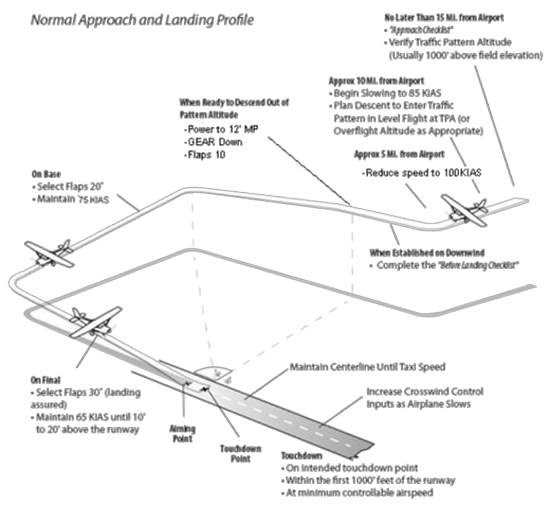
SOFT--FIELD APPROACH AND LANDING
- Enter and fly traffic pattern per standard procedures.
- Complete “Before Landing Checklist.”
- At Mid--Field-- GEAR down
- Reduce power to 12 inches MP, lower flaps to 10o, maintain altitude, and decelerate to 85 KIAS abeam intended point of touchdown.
- Turn base when intended point of touchdown is approximately 45o behind wing.
- Extend flaps to 20o.
- Turn final and maintain proper ground track.
- Extend flaps 30o.
- Below 100 knots, PROP full forward
- Reduce airspeed to recommended soft--field approach airspeed.
- Adjust pitch and power as necessary to maintain airspeed and descent angle.
- Reduce airspeed to 63 KIAS +5/--0 KIAS (include gust factor as necessary) on short final.
- Transition from approach to landing attitude approximately 10 feet above runway by using elevator pressure and apply crosswind correction as necessary.
- Touchdown smoothly at minimum descent rate and ground speed with no appreciable drift and airplane’s longitudinal axis aligned with and over runway centerline.
- Hold nose wheel off landing surface as long as possible by applying back elevator pressure.
- Maintain directional control during after--landing roll, and back pressure on soft surface.
* *GEAR configuration checks will be made during the Downwind, base and Final legs**
SHORT--FIELD APPROACH AND LANDING
- Enter and fly traffic pattern per standard procedures.
- Complete “Before Landing Checklist.”
- At Mid--Field-- GEAR down
- Apply carburetor heat and reduce power to 12 inches MP, lower flaps to 10o, maintain altitude, and decelerate to 85 KIAS abeam intended point of touchdown.
- Turn base when intended point of touchdown is approximately 45o behind wing.
- Extend flaps to 20o.
- Turn final and maintain proper ground track, extend flaps to 30o
- Below 100 knots, PROP full forward
- Reduce airspeed to 63 KIAS.
- Adjust pitch and power as necessary to maintain airspeed and descent angle that will ensure safe obstacle clearance.
- Reduce airspeed to recommended airspeed +10/--5 KIAS on short final.
- Transition from approach to landing altitude approximately 10 to 15 feet above runway by applying back elevator pressure and crosswind correction as necessary.
- Touchdown beyond and within 100 feet (Commercial) of intended touchdown point, with minimum float and no appreciable drift, and airplane’s longitudinal axis aligned with and over runway centerline.
- Maintain directional control after landing on ground roll by increasing aileron deflection into the wind as necessary. 15. Retract flaps, apply brakes and “up” elevator to stop in shortest distance consistent with safety. * *GEAR configuration checks will be made during the Downwind, base and Final legs**
POWER OFF 180° ACCURACY APPROACH AND LANDING
- Enter and fly traffic pattern per standard procedures.
- Complete Before Landing Checklist.
- At Mid--Field-- GEAR down
- Select a touchdown point no more than 1/3 down the runway length
- Abeam that intended touchdown point, Set power to IDLE, and Flaps recommended to 10°
- The recommended airspeed to pitch for is 80--85 knots.
- Apply flaps as necessary to adjust the rate of descent and airspeed.
- Transition from approach to landing altitude approximately 10 to 15 feet above runway by applying back elevator pressure and crosswind correction as necessary.
- Touchdown beyond and within 200 feet (Commercial) of intended touchdown point, with minimum float and no appreciable drift, and airplane’s longitudinal axis aligned with and over runway centerline.
* *GEAR configuration checks will be made during the Downwind, base and Final legs**
Note: *Airspeeds and decisions to turn at individual legs must be made by the PIC dependent on the current winds and flight conditions*
FORWARD SLIPS AND LANDING
- Enter and fly traffic pattern per standard procedures.
- Complete “Before Landing Checklist.”
- At Mid--field-- GEAR down
- Reduce power to 12 inches MP, maintain altitude, and decelerate to 75--80 KIAS abeam intended point of touchdown.
- Turn base when intended point of touchdown is approximately 45o behind wing.
- Turn final and maintain proper ground track.
- PROP full forward
- Reduce throttle to IDLE.
- Reduce airspeed to 70--75 KIAS flaps UP approach speed.
- Establish forward slip by simultaneously lowering a wing into wind and applying opposite rudder.
- Adjust pitch and amount of slip as necessary to maintain airspeed, descent angle, and directional control.
- Transition from slip to normal approach approximately 50 feet above the runway.
- Transition from approach to landing attitude approximately 10 to 15 feet above runway by applying back elevator pressure and crosswind correction as necessary.
- Touchdown smoothly at approximate stalling speed, beyond and within 400 feet of intended touchdown point, with no appreciable drift, and airplane’ longitudinal axis is aligned with and over runway centerline.
- Maintain directional control during after landing roll by increasing aileron deflection into the wind as necessary.
* *GEAR configuration checks will be made during the Downwind, base and Final legs**
GO--AROUND FROM A REJECTED LANDING
- Apply full Manifold Pressure and FULL Propeller, pitch to VX, attitude, and retract or maintain flaps to 20o.
- Establish a positive rate of climb, GEAR UP
- Pitch for Vx and retract flaps to 10
- Retract flaps at a safe altitude and airspeed (greater than 200 feet AGL).
- Maneuver to the side of the runway to clear and avoid conflicting traffic.
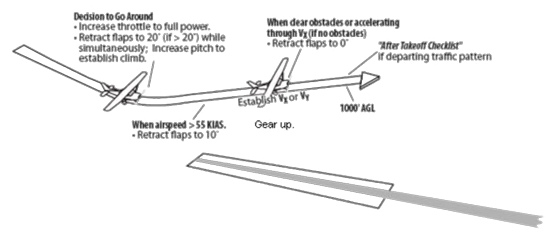
DIVERSION
The objective of this maneuver is to pilot the aircraft to an alternate airport in case the point of intended landing is no longer available. This can include reasons due to unpredicted weather, a system malfunction, or poor preflight planning.
- Once the decision to divert to an alternate airport is made, consideration should be given to returning to your last checkpoint or a prominent landmark and circling until your navigation planning is complete.
- Estimate an approximate heading, distance, and time enroute (ETE) to the alternate airport and note the time that the diversion began.*
- Turn to the estimated magnetic heading and attempt to identify any prominent landmarks nearby.
- If time permits, and once established on course towards the alternate airport, an accurate course, groundspeed, ETE, and fuel consumption can be determined using the E6B Flight Computer.
- Call the appropriate Flight Service Station (FSS) and approach control if applicable, to amend your flight plan and provide a pilot report (UA/UUA).
- Use the Airport Facilities Directory (AF/D) to determine any airport restrictions at the alternate airport.
- Identify airspace along the diversion route.
*Note: Because of limited cockpit space, and because attention must be divided between flying the airplane, making calculations, and scanning for other air traffic, take advantage of all possible shortcuts and rule of thumb calculations. For example: Use a straight edge and a VOR compass rose for magnetic heading. For groundspeed, 90 KIAS equals 1.5 nautical miles per minute. Thus, it would take approximately 7 minutes to travel 10 nautical miles, plus or minus winds aloft. For fuel consumption, the Cadet would use approximately .2 gallons/min. at 75% power. During a diversion, priority must be given to flying the airplane while dividing attention between navigation and planning.
LOST PROCEDURES
The objective of this maneuver is to identify different methods of determining aircraft location in the event of becoming lost during flight. This can occur during a cross country into unfamiliar terrain, by poor preflight planning, or restricted visibility due to weather.
- Climb, being mindful of traffic and weather conditions, to identify prominent landmarks.
- Scan the area around the aircraft for prominent landmarks to determine the aircraft’s location.
- Using the aircraft’s navigational instruments, plot an azimuth from either two VOR or NDB facilities, to determine approximate location.
- Circle, so as not to aggravate the situation or wander into restricted or controlled airspace.
- Communicate if still unable to determine location, and request assistance from ATC. Comply with all ATC or FSS instructions.
- Remain Calm at all times.
- Conserve fuel by reducing power to 55% and lean the mixture.
- If the situation becomes an emergency, squawk “7700” on the transponder and seek assistance on 121.50.
NO--FLAP LANDING
- Follow the normal traffic pattern operations procedure for arriving at a towered or non--towered airport.
- At Mid--Field, GEAR down
- Abeam the point of intended landing, reduce power to idle. Begin a gradual descent at 75 KIAS, approximately 1.5 VS1. Do not extend the flaps during the pattern.
- At a point approximately 45 degrees from the approach end of the runway, begin a medium bank turn onto the base leg and slow to 70 KIAS, 1.4 VS1.
- While on the base leg, visually clear the final approach area.
- Final approach:
- Set an aiming point in order to land within the first 1/3 of the runway.
- Flaps should remain retracted.
- No--flap approach speed 65 KIAS, 1.3 VS1.
- Maintain aiming point with pitch and power corrections until approaching round out.
- At the round out, reduce power to idle and continue the flare to touchdown on the main wheels first at approximately stalling speed.
- Upon touchdown, hold the nose wheel off the runway as long as the elevator remains effective to provide aerodynamic braking, as appropriate.
- Maintain directional control using rudder.
- Do not initiate the after--landing checklist until clear of the runway.
*Note: The descent angle in a no--flap condition is much shallower than when using flaps. Also, landing distances will be increased due to the higher approach speed used.
RECOVERY FROM UNUSUAL ATTITUDES
An unusual attitude is an airplane attitude not normally required for instrument flight. Unusual attitudes may result from a number of conditions such as turbulence, disorientation, or instrument failure, etc.
Nose--high attitudes.
Recognizing:
- Airspeed decreasing.
- Altitude increasing.
- VSI shows a climb.
Recovery:
- Apply full power.
- Simultaneously apply forward elevator pressure to lower the nose and use coordinated aileron and rudder pressure to level the wings.
- Resume straight--and--level flight.
- Return to assigned heading and altitude.
Nose--low attitudes.
Recognizing:
- Airspeed increasing.
- Altitude decreasing.
- VSI shows a descent.
Recovery:
- Reduce power to idle.
- Simultaneously correct the bank attitude with coordinated aileron and rudder pressure and apply smooth back--elevator pressure to raise the nose.
- Resume straight--and--level flight.
- Return to assigned heading and altitude.
Chandelles
- Perform two 90º clearing turns
- Note wind direction
- 110 KIAS --20 inches MP and 2300 RPM maintain altitude
- Clean configuration flow (GEAR up and FLAPS up)
- Choose a reference point off wing with a turn to be initiated INTO the wind
- Set PROP to 2500 rpm
- Establish / maintain 30° bank
- Throttle 25 Inches MP-- Increase pitch to attain approx. 10--12° pitch up at 90° point 1st 90° of turn, Bank = constant 30°, Pitch = increasing to 10--12° pitch up
- 90° point -- maintain pitch -- reduce bank angle to attain level flight at 180° point 2nd 90° of turn, Pitch = constant 10--12° pitch up, Bank = decreasing to level flight
- 180° point -- wings level -- minimum controllable airspeed
- Maintain roll out altitude +/-- 50Ft
- Accelerate while maintaining level flight
- Cruise checklist
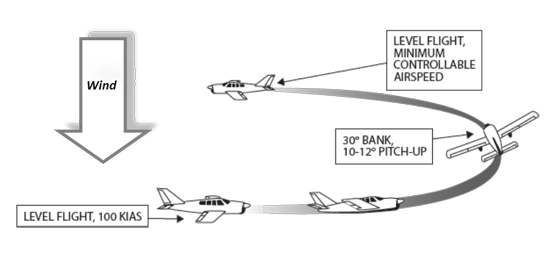
Lazy Eights
- Perform two 90º clearing turns
- 110 KIAS --20 inches MP and 2300 RPM maintain altitude
- Clean configuration flow (GEAR up and FLAPS up)
- Choose a reference point off of the wing to begin the turn INTO the wind.
- Simultaneously increase pitch and bank (SLOWLY)
- 45° point – 15° pitch up and 15° bank
- Reduce pitch / increase bank
- 90° point –level pitch -- 30° bank
- Continue reducing pitch and reduce bank
- 135° point -- 15° pitch down -- 15° bank
- 180° point – level flight – entry airspeed and altitude
- Repeat in opposite direction 13. Cruise checklist Steep
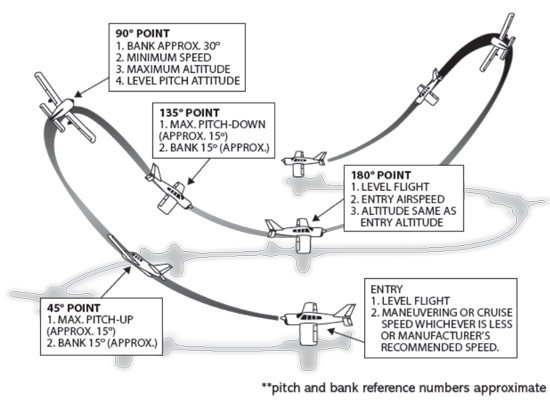
Spirals
- Pre--maneuver checklist
- Select an altitude to recover the maneuver no less than 4000 ft.
- Select a prominent but distinctive reference point
- 83 KIAS 15 inches MP and 2300 rpm maintain altitude
- When abeam the reference point, Power to IDLE
- Track at least three constant radius circles around reference point
- Maintain 83 knots +/-- 10 knots
- Engine to be cleared after each consecutive 360°
- After completion of the third 360° turn. Level the wings and smoothly apply power to 15--18 inches MP.
**Careful when applying full power as the engine will be cold. Verify with CHT gauge** 10. Exit maneuver on the same entry heading =/-- 10°
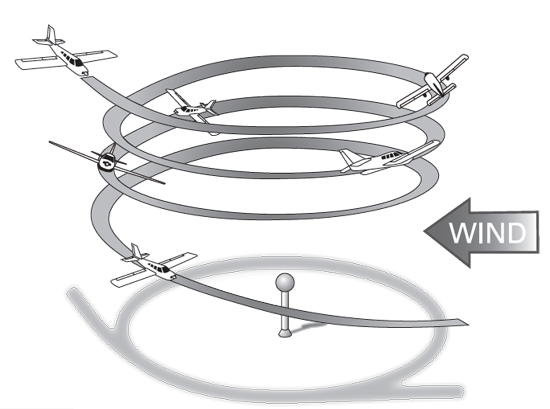
Eights On Pylons
- Pre--maneuver checklist
- Enter pivotal altitude (Approx. 900’ AGL at 100 KIAS –18 inches MP, 2300 RPM) Pivotal Altitude= GS2 ÷ 11.3
- Clean configuration flow (GEAR up and FLAPS up)
- Select two pylons to allow for minimal time spent wings level between the two, pylons should over flown and no more than 15--20 seconds apart.
- After overflying the pylons, turn into the wind to get setup to enter maneuver on a 45° midpoint downwind
- Apply appropriate pitch corrections to compensate for changes in groundspeed
- To maintain line of sight reference with the pylon (pitch forward if point moves toward nose and pitch back if point moves toward tail).
- Begin rollout to allow the airplane to proceed diagonally between the pylons at a 45º angle
- Begin second turn in the opposite direction of the first
- Exit maneuver on entry heading
- Cruise checklist
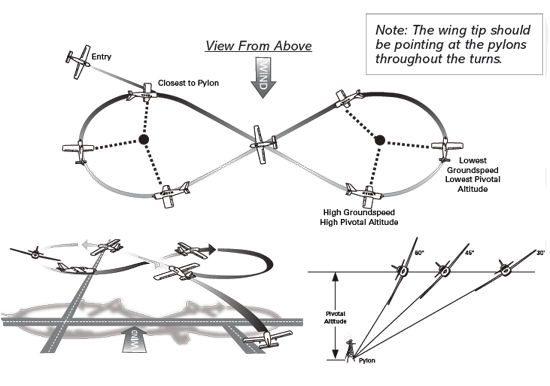
Instrument Procedures
Precision Approach (ILS Approach)
- 10--20 miles from the IAF, Complete the “Approach Checklist” and identify the localizer as early as possible.
- 3 minutes from the IAF, Slow to 100 KIAS.
- 3 miles from the FAF, Slow to 90 KIAS.
- Trim for 90 KIAS on vectors until established on a published segment of the approach.
- Announce “Localizer Alive” when localizer begins moving toward center.
- Announce “Glideslope Alive” when glideslope begins moving toward center.
- Verify no flags at glideslope intercept altitude and marker.
- 1 dot below glideslope intercept:
- Landing Checklist
- Select flaps 10°.
- Gear Down
- Prop full forward
- Intercept and track the Glide slope.
- Descend on glideslope at 90 KIAS. * It will take approx. 18’ MP and 500 FPM to stay on glideslope. 11. Standard Callouts “1000--500--300--200--100 above DA” and “Minimums”
- Upon Arrival at the Decision Altitude, the Pilot Flying Must decide to either land with one of the visual references mentioned in 91.175 or execute the Missed approach.
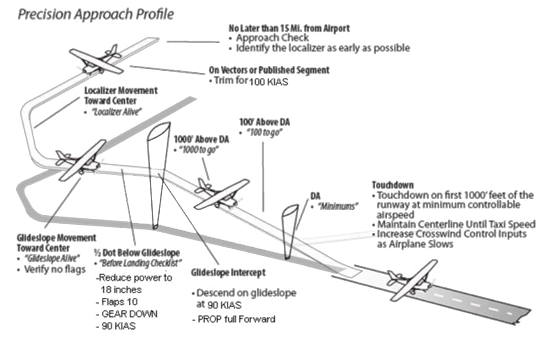
NON--Precision Approach (VOR/NBD/GPS…)
- 10--20 miles from the IAF, Complete the “Approach Checklist” and identify the facility as early as possible.
- 3 minutes from the IAF, Slow to 100 KIAS
- 3 miles from the FAF, Slow to 90 KIAS.
- Trim for 90 KIAS on vectors until established on a published segment of the approach.
- Announce “Course Alive” when course begins moving toward center.
- ½ mile from the Final Approach Fix:
- Landing Checklist
- Select flaps 10°.
- Gear Down
- Prop Full Forward
- Passing final approach fix descend at 700 FPM and 90 knots using approx. 18’ MP
- Standard Callouts “1000--500--300--200--100 above MDA” and “Minimums”
- Maintain the MDA +50 feet, --0 feet.
- Upon Arrival at the Missed approach point, the Pilot Flying Must decide to either land with one of the visual references mentioned in 91.175 or execute the Missed approach.
- Landing Checklist
- Select flaps 10°.
- Gear Down
- Prop Full Forward
